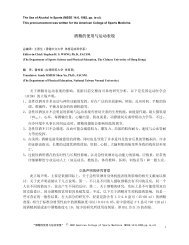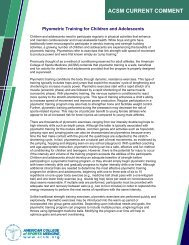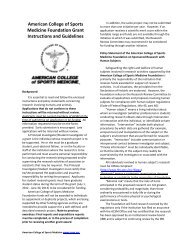Return to Play -- A Coach's Guide - American College of Sports ...
Return to Play -- A Coach's Guide - American College of Sports ...
Return to Play -- A Coach's Guide - American College of Sports ...
- No tags were found...
You also want an ePaper? Increase the reach of your titles
YUMPU automatically turns print PDFs into web optimized ePapers that Google loves.
ACSM Information On…<strong>Return</strong> <strong>to</strong> <strong>Play</strong> – A Coach’s <strong>Guide</strong>Injuries are a common occurrence for those who exercise. Whether it is tendinitis or an acute traumatic injury, many injuries require restriction<strong>of</strong> and/or change in your exercise program. The amount <strong>of</strong> time away from exercise varies according <strong>to</strong> the type <strong>of</strong> injury, severity <strong>of</strong> injury,body part involved and other situational fac<strong>to</strong>rs. Depending on the type and severity <strong>of</strong> the injury, you may experience pain, swelling, stiffness,weakness or decreased range <strong>of</strong> motion.A COMPLETE PHYSICAL ACTIVITY PROGRAMA well-rounded physical activity program includesaerobic exercise and strength training exercise, butnot necessarily in the same session. This blend helpsmaintain or improve cardiorespira<strong>to</strong>ry and muscularfitness and overall health and function. Regularphysical activity will provide more health benefits thansporadic, high intensity workouts, so chooseexercises you are likely <strong>to</strong> enjoy and that you canincorporate in<strong>to</strong> your schedule.ACSM’s physical activity recommendations for healthyadults, updated in 2011, recommend at least 30minutes <strong>of</strong> moderate-intensity physical activity(working hard enough <strong>to</strong> break a sweat, but still able<strong>to</strong> carry on a conversation) five days per week, or 20minutes <strong>of</strong> more vigorous activity three days perweek. Combinations <strong>of</strong> moderate- and vigorousintensityactivity can be performed <strong>to</strong> meet thisrecommendation.Examples <strong>of</strong> typical aerobic exercises are:• Walking• Running• Stair climbing• Cycling• Rowing• Cross country skiing• Swimming.In addition, strength training should be performed aminimum <strong>of</strong> two days each week, with 8-12repetitions <strong>of</strong> 8-10 different exercises that target allmajor muscle groups. This type <strong>of</strong> training can beaccomplished using body weight, resistance bands,free weights, medicine balls or weight machines.CONTROLLING THE INITIALSYMPTOMS (PRICE)• Protect: Protect the affected area fromfurther injury.• Rest: Rest and protect the injured part atfirst <strong>to</strong> experience less swelling and amore rapid recovery.• Ice: Put ice on the affected area <strong>to</strong>decrease swelling and help control pain.This is especially helpful in the first 48 <strong>to</strong>72 hours after injury.• Compression: Wrap or brace the injuredpart <strong>to</strong> allow for control <strong>of</strong> initial swellingand <strong>to</strong> decrease motion.• Elevation: Elevate the injured part,especially if it is kept above the heart, asthis helps decrease swelling and pain.HEALING TIMEHealing time depends on site, severity andtype <strong>of</strong> injury. For example, a mild anklesprain may heal in two <strong>to</strong> four weeks,while a fracture <strong>of</strong> the leg may take eight<strong>to</strong> 12 weeks. However, healing usuallyproceeds in certain stages.• Swelling and pain decreases ordisappears in the first 24 <strong>to</strong> 72 hours.• Discoloration and bruising usuallysubsides within ten <strong>to</strong> 14 days.• Range <strong>of</strong> motion increases over seven <strong>to</strong>14 days, though stiffness and weaknessmay persist.When an injury occurs, it may result inweakness, due <strong>to</strong> tissue damage anddisuse, and decreased control over thedamaged body part. Regaining strengthand coordination <strong>of</strong> the injured body partshould be considered part <strong>of</strong> therehabilitation and healing process.Attempting <strong>to</strong> return <strong>to</strong> an activity beforeproper healing <strong>of</strong> the injury puts you atrisk <strong>to</strong> reinjure yourself.
GUIDELINES FOR RETURN TOPLAYYou should have pain-free full range <strong>of</strong>motion. The injured body part should havefull movement and flexibility with little orno discomfort.• <strong>Return</strong> <strong>of</strong> strength: The injured bodypart should be approximately equal (90-95 percent) <strong>to</strong> the opposite side beforereturning <strong>to</strong> full activity.• Minimal pain or swelling: Some milddiscomfort, stiffness and/or swellingduring or after exercise is <strong>to</strong> be expectedduring the initial return <strong>to</strong> activity. Ice canbe used <strong>to</strong> alleviate these symp<strong>to</strong>ms.• Functional retraining: You should beable <strong>to</strong> effectively perform the specificmotions and actions required for yoursport before returning <strong>to</strong> activity. Forexample, retraining a lower-extremityinjury in basketball should involve theability <strong>to</strong> run, s<strong>to</strong>p, change directionsand jump.• Progressive return <strong>to</strong> activity:Consider starting at 50 percent <strong>of</strong>normal activity and progress as<strong>to</strong>lerable. An informal guideline you canuse is <strong>to</strong> progress activity 10-15 percentper week if the previous level <strong>of</strong> activitydoes not result in increased symp<strong>to</strong>msduring exercise or the day after exercise.• Continue general conditioning withcross-training: Doing an alternativeexercise allows maintenance <strong>of</strong> generalcardiovascular fitness while notinterfering with the healing <strong>of</strong> an injury.For example, ankle and knee injuriesmay do well with bicycling or swimming.• Mental confidence in ability <strong>to</strong> doexercise: You must feel that you andyour injury are ready <strong>to</strong> perform at thelevel required for your particular activity.If you have any questions about how theabove guidelines apply <strong>to</strong> your particularinjury, please consult with a sportsmedicine pr<strong>of</strong>essional.STAYING ACTIVE PAYS OFF!Those who are physically active tend <strong>to</strong> live longer,healthier lives. Research shows that moderatephysical activity – such as 30 minutes a day <strong>of</strong> briskwalking – significantly contributes <strong>to</strong> longevity. Even aperson with risk fac<strong>to</strong>rs like high blood pressure,diabetes or even a smoking habit can gain realbenefits from incorporating regular physical activityin<strong>to</strong> their daily life.As many dieters have found, exercise can help youstay on a diet and lose weight. What’s more – regularexercise can help lower blood pressure, control bloodsugar, improve cholesterol levels and build stronger,denser bones.THE FIRST STEPBefore you begin an exercise program, take a fitnesstest, or substantially increase your level <strong>of</strong> activity,make sure <strong>to</strong> answer the following questions. Thisphysical activity readiness questionnaire (PAR-Q) willhelp determine if you’re ready <strong>to</strong> begin an exerciseroutine or program.• Has your doc<strong>to</strong>r ever said that you have a heartcondition or that you should participate in physicalactivity only as recommended by a doc<strong>to</strong>r?• Do you feel pain in your chest during physicalactivity?• In the past month, have you had chest pain whenyou were not doing physical activity?• Do you lose your balance from dizziness? Do youever lose consciousness?• Do you have a bone or joint problem that could bemade worse by a change in your physical activity?• Is your doc<strong>to</strong>r currently prescribing drugs for yourblood pressure or a heart condition?• Do you know <strong>of</strong> any reason you should notparticipate in physical activity?If you answered yes <strong>to</strong> one or more questions, if youare over 40 years <strong>of</strong> age and have recently beeninactive, or if you are concerned about your health,consult a physician before taking a fitness test orsubstantially increasing your physical activity. If youanswered no <strong>to</strong> each question, then it’s likely that youcan safely begin exercising.PRIOR TO EXERCISEPrior <strong>to</strong> beginning any exercise program, including theactivities depicted in this brochure, individuals shouldseek medical evaluation and clearance <strong>to</strong> engage inactivity. Not all exercise programs are suitable foreveryone, and some programs may result in injury.Activities should be carried out at a pace that iscomfortable for the user. Users should discontinueparticipation in any exercise activity that causes painor discomfort. In such event, medical consultationshould be immediately obtained.ACSM grants permission <strong>to</strong> reproduce this brochure if it is reproduced in its entirety without alteration. The text may be reproduced in another publication if it is used in its entiretywithout alteration and the following statement is added: Reprinted with permission <strong>of</strong> the <strong>American</strong> <strong>College</strong> <strong>of</strong> <strong>Sports</strong> Medicine. Copyright © 2011 <strong>American</strong> <strong>College</strong> <strong>of</strong> <strong>Sports</strong>Medicine. This brochure was created and updated by Lawrence M. Magee, M.D., FACSM, and is a product <strong>of</strong> the <strong>American</strong> <strong>College</strong> <strong>of</strong> <strong>Sports</strong> Medicine. Visit ACSM online atwww.acsm.org.
















